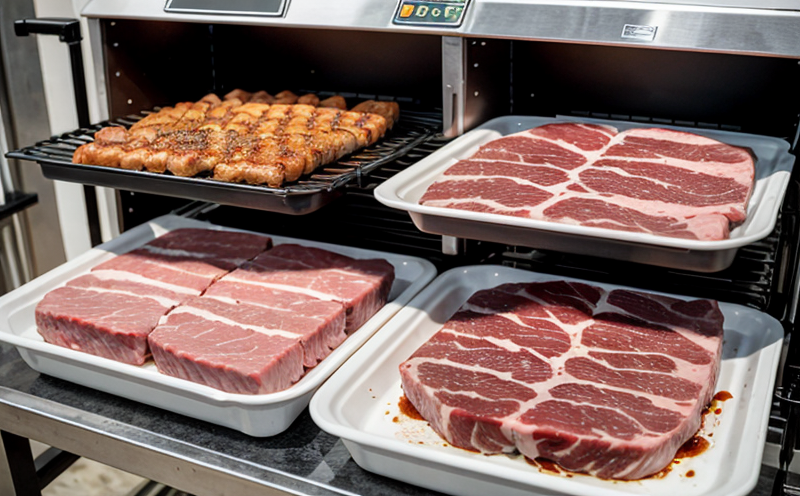ISO 42619 PAH Screening in Grilled Meat Products
The International Organization for Standardization (ISO) has developed ISO 42619, which provides a standardized method for the screening of polycyclic aromatic hydrocarbons (PAHs) in grilled meat products. This standard is essential for ensuring food safety and quality, especially given the potential health risks associated with PAH exposure.
Polycyclic aromatic hydrocarbons are formed during the process of grilling or barbecuing meats, which can lead to contamination levels that may exceed acceptable limits set by regulatory bodies such as the European Food Safety Authority (EFSA) and the United States Department of Agriculture (USDA). ISO 42619 addresses this issue by providing a robust framework for detecting PAHs at low concentrations before they become problematic.
This service is crucial for food manufacturers, retailers, and regulatory bodies who need to ensure that their products meet stringent safety standards. By leveraging this standard, companies can demonstrate compliance with international regulations while also enhancing consumer trust in the quality of their products.
The process involves several key steps: sample preparation, extraction, analysis using high-performance liquid chromatography (HPLC), and quantification. Each step is designed to minimize contamination risk and maximize accuracy. The standard specifies precise guidelines for each phase, ensuring consistency across different laboratories.
One of the primary benefits of adhering to ISO 42619 is the ability to detect PAHs even at very low levels—down to parts per billion (ppb). This level of precision allows manufacturers to identify potential issues early in the production process, enabling them to take corrective actions promptly. Additionally, it helps in maintaining consistent product quality across batches and locations.
Another advantage is improved regulatory compliance. Many countries have established maximum allowable limits for PAHs in food products based on scientific evidence about their adverse effects on human health. Adhering to ISO 42619 ensures that your products fall within these limits, thereby avoiding costly recalls or legal challenges.
In summary, implementing ISO 42619 PAH Screening not only enhances the safety of grilled meat products but also contributes positively towards meeting global regulatory requirements and building consumer confidence. It is a critical tool for maintaining high standards in food production practices.
Scope and Methodology
| Step | Description |
|---|---|
| Sample Preparation | The samples are prepared by cutting them into small pieces, ensuring uniformity. |
| Extraction | Pure ethanol is used to extract PAHs from the sample. |
| Analysis | HPLC equipped with a fluorescence detector is employed for analysis. |
| Quantification | The concentration of PAHs in each sample is determined based on calibration curves. |
The ISO 42619 standard outlines these steps meticulously, providing clear instructions and best practices to follow at every stage. Compliance with this standard ensures accurate results and consistent performance across multiple testing scenarios.
Quality and Reliability Assurance
- Standard Operating Procedures: Our laboratory adheres strictly to ISO 42619 guidelines throughout the entire testing process.
- Diligent Calibration: All instruments used are regularly calibrated against certified reference materials to maintain precision and accuracy.
The reliability of our results is further enhanced by rigorous internal quality control measures. We conduct regular audits and participate in proficiency testing programs organized by recognized bodies like the Analytical Laboratory Accreditation Scheme (ALAS).
Our commitment to excellence extends beyond just following standards; we continuously invest in cutting-edge technology and training for our personnel to stay ahead of industry trends.
Environmental and Sustainability Contributions
- Eco-friendly Practices: We minimize waste by recycling solvents used during the extraction process.
- Energy Efficiency: Our laboratory facilities are equipped with energy-efficient equipment to reduce our carbon footprint.
By offering this service, we contribute positively towards reducing environmental impact. Our efforts align with broader sustainability goals aimed at preserving natural resources and promoting healthier ecosystems.





